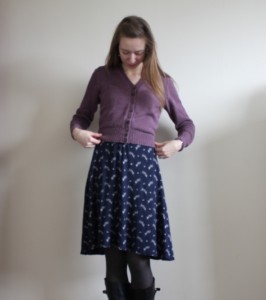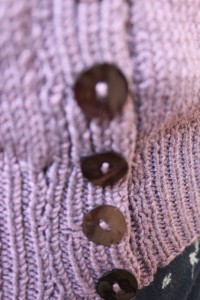I have finally knitted a wearable sweater! 
I found this 1950s pattern in a local charity shop, and bought it because I’ve always wanted to try a vintage sweater pattern. In fact it was very easy to knit, and I did big portions of it watching TV and on the train into London, nearly finishing it back in September or October. However, once I assembled the pieces I felt that the sleeves were a little more baggy than I would prefer, and, depressed by how much effort I’d invested, I didn’t finish it and put it away. Finally, though, I pulled it out again and decided to reassess the sleeves. I still wasn’t sure, but opted to go ahead and buy buttons to finish it off, if for no other reason than to prove to myself that I could knit something that was at least wearable, if not perfect.
You know what? I really, really like it. The sleeves don’t bother me as much now, and if in the future I want to redo them, I think I could adjust the pattern for a slimmer fit. It’s not that hard to unravel knitting and re-knit a piece with the same yarn.
I have a fairly long (but fraught) history of knitting. I’ve known the basics for a long time, and for many years I had one pair of knitting needles that were my own and on which I would knit blankets and scarves for my toys. As a teenager and young university student, I branched out into some attempts at cardigans, and while I knitted prolifically I struggled to produce anything that was very wearable. Some of that was incompetence – wonky cardigans with two sides that didn’t match up, edges that rolled, etc. Much of the problem was poor choice of yarn, and not knowing where to find patterns that looked like wearable garments for my own taste instead of boxy, artsy-craftsy styles.
For this cardigan, I chose a yarn of natural fibres (I think it’s a bamboo/cotton blend, from a couple of years ago) rather than a cheap acrylic, and the pattern had a better range of sizes than I’ve sometimes seen and a more trim fit through the bodice. Altogether, those things made this actually a wearable garment. I also splurged a little on the buttons, reasoning that if you’ve bothered to knit a whole cardigan, you should buy buttons that enhance it, rather than cheapen it.
I noticed a couple of interesting features to this pattern. As you can see, it has the classic 50s slim-waisted fit. When the sweater is lying flat, you can see that wasp-waisted shape characteristic of other knits I’ve seen from the period – it looks too thin at the waist and angles out sharply. In fact, the waist in this case is smaller than my waist, meaning that the ribbing stretches to fit snugly. Also, notice how many buttons there are and how high up they come! This is one difference I do sometimes notice between vintage or homemade garments and ready-to-wear clothing, that buttons are more closely spaced in older and homemade clothes. There’s no gaping or pulling between them as a result.
 This sweater is not perfect. I’ve restrained myself and saved this comment for the end instead of using it as a disclaimer at the beginning! But I don’t suppose any of my readers would point out the flaws. I make a point of saying this partly because I think it’s encouraging to read about others’ projects and realise that they’re not always flawless, but that it can be just fine to wear a garment or display a creation that isn’t perfect. And I make this point to myself as well, because I can be far too perfectionistic in my various handcrafts. To any friend, I would say, Why bother liking the project less because it isn’t perfect? You knitted a sweater from scratch!! Feel accomplished!! (Double punctuation intentional.) So I’m trying to tell myself the same. (And telling it to myself about my thesis as well, incidentally.) Looking at this sweater now, I think I would have worn it a lot over the winter if I had just finished it back in October, instead of casting it away because of its imperfections!
This sweater is not perfect. I’ve restrained myself and saved this comment for the end instead of using it as a disclaimer at the beginning! But I don’t suppose any of my readers would point out the flaws. I make a point of saying this partly because I think it’s encouraging to read about others’ projects and realise that they’re not always flawless, but that it can be just fine to wear a garment or display a creation that isn’t perfect. And I make this point to myself as well, because I can be far too perfectionistic in my various handcrafts. To any friend, I would say, Why bother liking the project less because it isn’t perfect? You knitted a sweater from scratch!! Feel accomplished!! (Double punctuation intentional.) So I’m trying to tell myself the same. (And telling it to myself about my thesis as well, incidentally.) Looking at this sweater now, I think I would have worn it a lot over the winter if I had just finished it back in October, instead of casting it away because of its imperfections!

One thought on “Some Vintage Knitting”